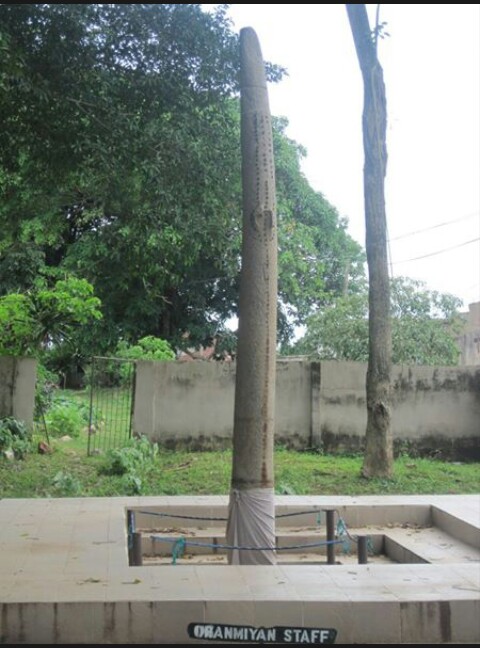Oranmiyan is an important character in Yoruba and Benin mythology. Though the youngest of Oduduwa grandchildren according to Ife oral tradition, he eventually became the most powerful and famous of them all. According to Ife’s list of kings compiled in Oonis Palace, Oranmiyan, the sixth Ooni of Ife had the singular honour of founding two existing dynasties of Oyo and Benin via two of his sons: Ajaka and Eweka.
Oranmiyan staff, located at Mopa along Arubidi Road, Ile-Ife is dedicated to Oranmiyan. On global positioning system, it is situated on an elevation of about 28 meters above sea level. The staff is the most spectacular antiquity in Ile-Ife and is believed to be one of the tallest stone sculptures in the south of the Sahara. It is a granite column of about 18feet (5.5cm) in height and about 4 feet square in width at the base. Several iron studs were driven into it. The belief is that it was erected on the spot where Oranmiyan was originally buried. However, an archaeological investigation has proven otherwise.
The iron studs on Oranmiyan staff had been interpreted at various times as a diary of events in the life of Oranmiyan as a warrior. Some believed it represents record of festivals in Ile-Ife. Chief Eredumi Akinyemi, Priest of Oranmiyan, believes that the iron studs represent the number of bullets fired at Oranmiyan during war of expansion.
According to Johnson (1921:146), the iron studs are suggestive to represent Hebrew letter Resh and Yod. Johnson further interpreted the 62 iron studs in the middle of the stone monolith to mean the number of years Oranmiyan spent to fight war of expansion, while the 31 iron studs on either side of the staff represent the number of years he stayed in Oyo and Benin respectively. However, a cursory look at the topmost part of the staff actually depicts a vivid picture of the sacred Aare crown.
The written character on the staff actually gave us a clue to the fact that Yoruba at a point in history had developed some forms of ancient writing that is evident in Ifa corpus (signatures) walls of Oluorogbo, Akire and Obalejugbe Shrines in Ile-Ife. Oranmiyan staff equally suggests that carving in stone is part of the artistic tradition in Ile-Ife. The concept and quality of the art demonstrates the richness and sophistication of Ife cultural tradition. The style and technique further reveals that Ife must have had knowledge of iron working long before the advent of Europeans.
Aside from Oranmiyan staff, Ore stone mud fish in National Museum, Ile-Ife is another example of Ife stone object with iron drilled into it. The number of iron smelting sites in Ife and its environ in the time past are physical evidence that the technology behind the combination of stone objects with the iron studs is indigenous to Ife. According to Johnson, it is on record that between 1884 and 1953, the stone monolith fell down on two occasions as a result of heavy rain storm.
The cultural significance of Oranmiyan staff lies in the fact that it is connected to the installation rites for Ooni of Ife and Alaafin of Oyo. In the past, before an Alaafin was enthroned or crowned, part of his installation rites requires that he must come physically to Oranmiyan grove for a very important rite and the ceremony of receiving sword of authority before he could be crowned as Alaafin. Thus, the rites symbolise his authority and legitimacy on the throne.
According to Ife oral tradition, corroborated by Chiefs Eredumi, Apata and Akogun, Yoruba Obas and Are Ona Kakanfo (Yoruba generalissimo) before going to war in the time past, usually come to Ife and offer sacrifices to the deity of Oranmiyan and the staff to ensure victory. Till today, people still come to pray before the staff. According to Chief Eredumi, it is believed that whatever prayer that is offered before the staff would be answered. The healing power inherent in the staff is what had been attracting visitors to the grove and this explains ritual items found in the vicinity of the staff. The associated festival to Oranmiyan staff is Olukere-mude celebrated in the month of April and Olojo festival celebrated in October.


Leave a Reply